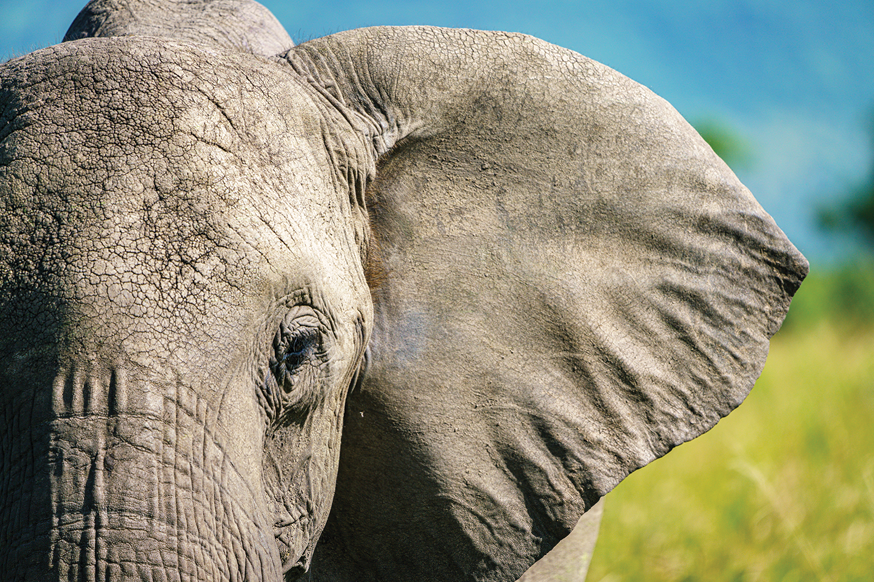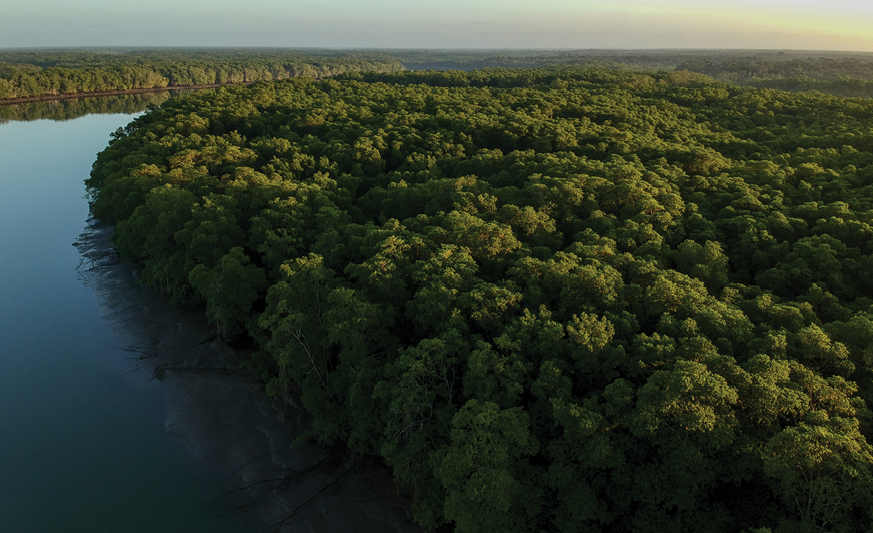- Home
- Media Kit
- Current Issue
- Past Issues
- Ad Specs-Submission
- Ad Print Settings
- Reprints (PDF)
- Photo Specifications (PDF)
- Contact Us

![]()
ONLINE

Protecting Nature,
Biodiversity and Ecosystems
Editors’ Note
M. Sanjayan is a global conservation scientist whose work spans from genetics to wildlife migration to nature’s impacts on human well-being. He has served as Conservation International’s chief executive officer since 2017. Sanjayan joined Conservation International in 2014 and leads the organization’s efforts to address the climate crisis by identifying, protecting and restoring climate-critical ecosystems. His peer-reviewed scientific work has been published in journals including Science, Nature and Conservation Biology. He is a visiting researcher at UCLA and a distinguished professor of practice at Arizona State University. He is also a Catto Fellow at the Aspen Institute. Sanjayan holds a master’s degree from the University of Oregon and a doctorate from the University of California, Santa Cruz.
Organization Brief
Conservation International (conservation.org) works to spotlight and secure the critical benefits that nature provides to humanity. Since its inception, it has helped to protect more than 6 million square kilometers (2.3 million square miles) of land and sea across more than 70 countries. Conservation International works with over 2,000 partners in 30 countries worldwide. Building upon a strong foundation of science, partnership and field demonstration, Conservation International empowers societies to responsibly and sustainably care for nature, our global biodiversity, and for the well-being of humanity. Its vision sees a healthy, prosperous world in which societies are forever committed to caring for and valuing nature for the long-term benefit of people and all life on Earth.

Maasai Mara National Reserve – An area of preserved savannah
wilderness in southwestern Kenya, along the Tanzanian border.
Its animals include lions, cheetahs, elephants, zebras and hippos.
Wildebeest traverse its plains during their annual migration.
The landscape has grassy plains and rolling hills, and is crossed
by the Mara and Talek rivers. The area nearby is dotted
with villages (enkangs) of Maasai people.
Will you provide an overview of Conservation International and how you define its mission?
Our mission is to protect nature, protect biodiversity and ecosystems, so that people everywhere can thrive. At no time in history has our mission been more important and more self-evident than today. We partner with communities and Indigenous peoples, businesses and governments, in over 30 countries, mostly tropical, to set up models of conservation that protect nature and also enhance human well-being. We aim for self-sufficiency in the long run.
That work can take a few different forms, but it always starts with science and always involves local partners and local communities. We help work with coastal communities to restore mangrove ecosystems that minimize coastal storm damage and store vast amounts of carbon. We work with governments to establish marine protected areas that enhance livelihoods for local people. We work with some of the biggest companies in the world to protect and restore forests to safeguard supply chains and also to blunt climate change.
“Our goal, ultimately, is to make ecosystems more resilient so they can continue to provide for people.”
How do you describe your leadership style and what do you see as the keys to effective leadership?
It is my job to try and understand what tomorrow looks like, what next month looks like, what next year looks like and beyond. To create a mental model of the future and be able to articulate it with enough conviction that others can see it too. However, how I function as a leader is really more like a coach, perhaps a basketball coach, rather than as the star player. It takes relentless teamwork, cooperation and practice to execute the perfect play, and my job is to help make those kinds of plays possible. When it happens it’s a thing of beauty and grace.
Two traits are essential for effective leadership. The first is having a clear sense of your values. It’s relatively easy to teach someone a skill, but it’s incredibly difficult to teach them values. It’s easy to espouse values in good times or in the abstraction of a poster on the company wall. It’s far more difficult in the ambiguity of real life when there is an actual short-term cost associated with it. That’s why value-based leadership is the main thing I look for when I make hiring decisions.
The second is the ability to relentlessly seek feedback. You will never be able to evolve and grow as a leader unless you can hear the music inside and outside the organization. Your ability to evolve is dependent on it. If you’re not seeking feedback, you end up in stasis or, even worse, with an organization in stasis.

A sustainable fishing project (Projeto Pesca Mais Sustentável)
in the Extractive Reserve of São João da Ponta, Pará, Brazil.
The liveilihoods of the local inhabitants are dependent mainly
on agriculture, fishing and catching crabs.
How do you define resilience and what is the role of a conservation organization in building resilience?
That’s an interesting question because resilience is really at the heart of everything we do at Conservation International. Our goal, ultimately, is to make ecosystems more resilient so they can continue to provide for people. The key idea here is that the more diverse an ecosystem is, the healthier it becomes and the healthier it is, the more benefits it can provide to people. Coral reefs, for example, tend to be healthier and stronger when they have lots of different kinds of coral, fish and sharks. That diversity then creates a more robust food supply for local communities, and it also provides a natural barrier against flooding and storm surges.
You can apply the same lessons to organizations themselves which often function like a biological ecosystem. More diversity promotes resilience and the ability to grow and evolve.
Will Conservation International shift its strategy as a result of recent events including the pandemic, social injustice, poverty, advancing of global temperatures and more intense natural disasters?
The fundamental premise of Conservation International is that people need nature to survive, a fact that all of the issues you mention have made even more clear. We are not shifting our strategy, but we are placing a greater emphasis on the areas of connection between our work and the solutions to these issues. Take tropical forests, for example. Protecting the tropics is essential to slowing down the pace of climate change, so we reduce incentives for deforestation by making it more valuable for people to keep trees standing than it is to cut them down. Keeping these habitats intact is critical to pandemic prevention efforts as well. It doesn’t change our strategy, but it may impact the places we identify for protection and the way we understand their value.
At the same time, Indigenous peoples have actively stewarded tropical rainforests for thousands of years. We will never effectively protect nature unless we partner with communities that are on the front lines of conservation. We’ve known this for a while, but these past few months have further emphasized that social justice and equity are an inextricable part of our work.
How are you able to build a resilient culture within your organization?
I consider myself Conservation International’s storyteller-in-chief. When everyone on the team clearly knows what we are working towards, how we intend to get there, and what the future could look like within the narrative arc of a story, it becomes a lot easier to stay on target during uncertain times. That’s partly how we were able to minimize productivity disruptions when we transitioned to remote work back in March. This pandemic has shown us a lot of things about our institutions and societies, but I think one of its biggest lessons is that our economic and public health are deeply intertwined with the health of our planet. For all of us at Conservation International, it was a tragic reminder of the significance of our work and a significant motivation to double down on our efforts.
How has your personal resilience helped to drive your work?
We are all the product of our experiences, and while my experiences are by no means unique, they are distressingly rare in global non-profit organizations. The fact of the matter is that I was born in Sri Lanka and raised in rural West Africa. I spent my entire childhood in the types of communities that conservation organizations must serve if we are going to succeed in saving nature, but I never once imagined that I could work in conservation, much less that I would one day be given the opportunity to lead an organization like Conservation International. The only reason I’m here is because at key moments in my life a few amazing people spoke up for me. I don’t take credit for those opportunities, but I do take responsibility for what I do with them. When our Board appointed me as CEO, my promise to our global team was simple; we would not live wasted lives and I work every day to keep that promise.
Finally, I would say that my family and my close group of friends are an infinite pool of support and resilience and I cannot imagine going at this alone.
Who are some of the resilient leaders you see today?
To me, the art of being resilient is nested in being truly comfortable with who you are and leading from an inner sense of purpose and confidence. A lot of people have shown this kind of resilience over the years, but three, perhaps because they are in the news, immediately come to mind: Joe Biden, Angela Merkel and Tim Cook.
Joe Biden and Angela Merkel have both overcome incredible personal difficulties over the course of exceptionally long public careers. They’ve both shown an amazing ability to grow from these experiences and come out the other side as stronger, more empathetic and more determined leaders.
Tim Cook has shown a different, but no less remarkable, kind of resilience. Speaking from personal experience, it’s never easy to follow in the footsteps of a legendary founder. You have to walk a very fine line between being true to the values that your predecessor set while still forging a new path forward for your organization, and from my limited view from afar, Tim Cook seems to have struck that balance with incredible fortitude and grace.![]()